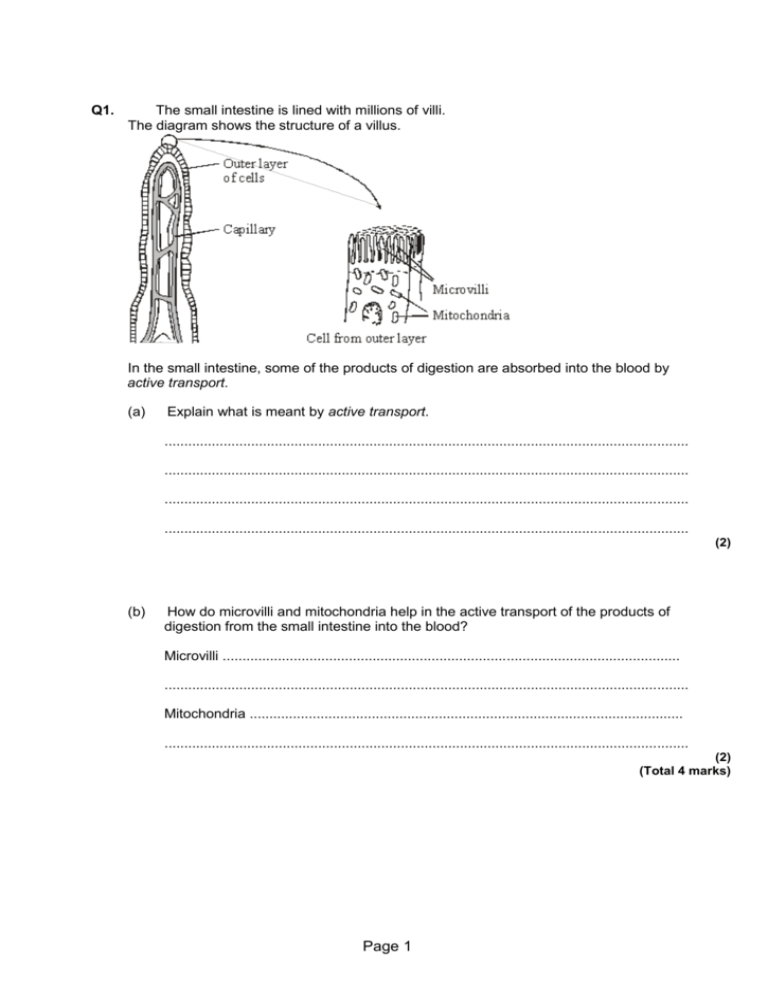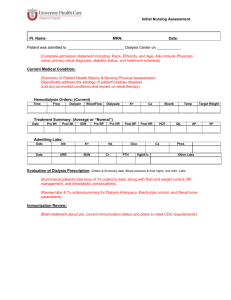More B3 cell transport questions
advertisement

Q1. The small intestine is lined with millions of villi. The diagram shows the structure of a villus. In the small intestine, some of the products of digestion are absorbed into the blood by active transport. (a) Explain what is meant by active transport. ..................................................................................................................................... ..................................................................................................................................... ..................................................................................................................................... ..................................................................................................................................... (2) (b) How do microvilli and mitochondria help in the active transport of the products of digestion from the small intestine into the blood? Microvilli .................................................................................................................... ..................................................................................................................................... Mitochondria .............................................................................................................. ..................................................................................................................................... (2) (Total 4 marks) Page 1 Q2. Diagram 1 shows two villi in the small intestine of a healthy person. (a) Describe two features of the villi which help the small intestine to function. 1 ................................................................................................................................. .................................................................................................................................... 2 ................................................................................................................................. .................................................................................................................................... (2) (b) Diagram 2 shows two villi in the small intestine of a person with coeliac disease. (i) How do the villi of the person with coeliac disease differ from those of a healthy person? .......................................................................................................................... .......................................................................................................................... Page 2 (1) (ii) Suggest how this difference might affect how well the small intestine functions. .......................................................................................................................... .......................................................................................................................... (1) (Total 4 marks) Q3. In fish and chip shops, potatoes are cut into chips several hours before the chips are cooked. The amount of water in the chips must be kept constant during this time. To keep the water in the chips constant, the chips are kept in salt solution. A student investigated the effect of different concentrations of salt solution on the mass of five chips. • He weighed each one of the five chips. • He placed each chip into a different concentration of salt solution. • After one hour he removed the chips from the salt solutions and then reweighed the chips. Concentration of salt solution 0M 0.5 M 1M 2M 3M Mass of chip at start, in grams 2.6 2.8 2.8 2.5 2.6 Mass of chip after one hour, in grams 2.7 2.8 2.7 2.3 2.1 (a) (i) In which concentration of salt solution did the chip gain mass? ................. (1) (ii) Explain why the chip gained mass in this solution. ............................................................................................................... Page 3 ............................................................................................................... ............................................................................................................... ............................................................................................................... ............................................................................................................... (2) (b) In which concentration of salt solution should the chips be kept in the shop? Give the reason for your answer. ........................................................................................................................ ........................................................................................................................ ........................................................................................................................ ........................................................................................................................ ........................................................................................................................ (2) (Total 5 marks) Q4. Some students set up this experiment to investigate osmosis. They filled two pieces of dialysis [visking] tubing with different liquids and left them both in a beaker of 5% sucrose solution for an hour. Page 4 (a) Describe and explain the likely results after one hour. ..................................................................................................................................... ..................................................................................................................................... ..................................................................................................................................... ..................................................................................................................................... ..................................................................................................................................... ..................................................................................................................................... ..................................................................................................................................... ..................................................................................................................................... (6) (b) Describe two examples where osmosis is used in living things. ..................................................................................................................................... ..................................................................................................................................... ..................................................................................................................................... ..................................................................................................................................... (2) (Total 8 marks) Q5. The diagram shows four ways in which molecules may move into a cell and out of a cell. The dots show the concentration of molecules. Page 5 The cell is respiring aerobically. Write the correct letter, A, B, C or D, next to each process. Arrow A, B, C or D Process The movement of oxygen molecules The movement of carbon dioxide molecules The active uptake of glucose molecules (Total 3 marks) Q6. (a) Some scientists investigated the rates of absorption of different sugars by the small intestine. In one experiment they used a piece of normal intestine. In a second experiment they used a piece of intestine poisoned by cyanide. Cyanide is poisonous because it prevents respiration. The results are shown in the table. Relative rates of absorption Sugar Normal intestine Intestine poisoned by cyanide Page 6 Glucose 1.00 0.33 Galactose 1.10 0.53 Xylose 0.30 0.31 Arabinose 0.29 0.29 (i) Name two sugars from the table which can be absorbed by active transport. 1 ........................................................................................................................ 2 ........................................................................................................................ (1) (ii) Use evidence from the table to explain why you chose these sugars. ........................................................................................................................... ........................................................................................................................... ........................................................................................................................... ........................................................................................................................... ........................................................................................................................... ........................................................................................................................... ........................................................................................................................... (3) (b) All of the sugars named in the table can be absorbed by diffusion. Explain how information from the table provides evidence for this. ..................................................................................................................................... ..................................................................................................................................... ..................................................................................................................................... ..................................................................................................................................... ..................................................................................................................................... (2) (Total 6 marks) Page 7 Q7. (a) Which two of the following substances are found in the urine of a healthy person? Tick ( ) two boxes. Glucose Mineral ions Proteins Water (2) (b) A person with kidney disease can be treated by dialysis. The diagram shows how dialysis works. The circles represent molecules of different substances. Draw a ring around the correct word or phrase to complete each sentence. Page 8 blood cells (i) During dialysis, urea moves out of the blood plasma . dialysis fluid (1) blood cells (ii) During dialysis, urea moves into the blood plasma . dialysis fluid (1) diffusion (iii) Urea moves by the process of digestion . transpiration (1) impermeable (iv) To allow the movement of urea, the dialysis membrane is partially permeable . thick (1) (v) The urea can pass through the membrane because large the urea molecules are round . small Page 9 (1) (c) For most patients a kidney transplant is better than continued dialysis treatment. Tick ( ) one box to complete the sentence. One major problem with a kidney transplant is that drug treatment is needed to suppress the immune system. hospital visits are needed three times a week. yearly costs are higher than for dialysis. (1) (Total 8 marks) Q8. The kidneys remove waste materials from the liquid part of the blood. The table shows the concentration of certain substances • in the liquid part of the blood • in the liquid that has just been filtered from the blood in the kidneys • in the solution in the bladder. Page 10 (a) (i) Which one of these substances does not pass into the liquid that is filtered in the kidneys? ........................................................................................................................... (1) (ii) Suggest one reason why this substance does not pass out of the blood. ........................................................................................................................... (1) (b) Explain why the concentration of urea in the liquid in the bladder is much greater than the concentration of urea in the liquid that is filtered in the kidneys. ..................................................................................................................................... ..................................................................................................................................... (1) (c) (i) Describe how a kidney dialysis machine works. ........................................................................................................................... ........................................................................................................................... ........................................................................................................................... ........................................................................................................................... ........................................................................................................................... ........................................................................................................................... (3) (ii) Use the data in the table to suggest the concentration that the salt in the dialysis fluid should be. Explain your answer. Concentration ............................................ Explanation ...................................................................................................... ........................................................................................................................... ........................................................................................................................... Page 11 (2) (Total 8 marks) Page 12 M1. (a) any two from: • transport up / against concentration gradient / low to high concentration • uses energy • use of protein / carrier 2 (b) microvilli – large(r) surface area accept have carriers 1 mitochondria – release energy or make ATP do not accept ‘makes energy’ 1 [4] M2. (a) any two from: • large surface / area or many villi or have microvilli accept big surface / area • thin surface or thin wall or surface 1-cell thick or capillaries near surface or permeable or partially permeable accept they are thin do not allow thin cell wall • many blood vessels or many capillaries or capillary network or good blood supply ignore ‘constant blood flow’ owtte ignore extras eg moist or reference to gases • have enzymes ignore release enzymes • accept reference to lacteal as 5th point • allow reference to having mitochondria 2 Page 13 (b) (i) small(er) (surface area) / flat(ter) / short(er) or not as folded or fewer capillaries owtte allow small(er) lacteal ignore references to wide / thick / spread out etc 1 (ii) less absorption (of digested food) / less digestion / diffusion accept slower for less accept description of less digestion accept less food can get in do not allow zero absorption do not allow ‘collection’ of nutrients 1 [4] M3. (a) (i) 0M 1 (ii) water entered cells by osmosis 1 because the concentration of water outside cells was higher than inside the cells 1 (b) 0.5 M 1 because the chip did not change mass in this solution 1 [5] Page 14 M4. (a) award 3 marks per tube for each key idea for tube 1: expands or gets firmer or bigger or inflates it gains water because the concentration of water is less than its surroundings make sure answer is about water movement and not sucrose solution 3 for tube 2 gets floppy or flaccid or contracts it loses water because the concentration of water is greater than its surroundings 3 (b) any 2 from: uptake of water by root (hair) or movement from cell to cell within plant do not credit references to diffusion unless it is clear that the candidate is referring to the diffusion of water guard cell function maintain turgor water absorption in the large intestine reabsorption of water from the nephron or collecting duct or in kidney or osmoregulation in kidney allow osmosis in other animals if some use is shown 2 [8] Page 15 M5. D 1 A 1 C 1 [3] M6. (a) (i) glucose and galactose 1 (ii) any three from: Evidence: • absorption reduced by cyanide allow converse • absorb faster (than other sugars) Explanation: • active transport needs energy • less / no energy available / released if cyanide is there or less / no energy if no / less respiration allow energy produced ignore cyanide prevents respiration 3 (b) all / the sugars / they can be absorbed when gut poisoned / with cyanide or when no respiration 1 (diffusion) does not need an energy supply 1 [6] Page 16 M7. (a) mineral ions 1 water each extra box ticked cancels 1 mark 1 (b) (i) blood plasma 1 (ii) dialysis fluid 1 (iii) diffusion 1 (iv) partially permeable 1 (v) small 1 (c) drug treatment is needed to suppress the immune system 1 [8] ## (a) (i) protein for 1 mark Page 17 1 (ii) e.g. molecules too large for 1 mark 1 (b) e.g. most of water reabsorbed, but little urea for 1 mark 1 (c) (i) restores concentration of dissolved substances, to normal level, wastes pass into dialysis fluid for 1 mark each 3 (ii) the same (0.35) or slightly below (<0.35), so that concentration of salts in blood remains constant for 1 mark each 2 [8] Page 18




